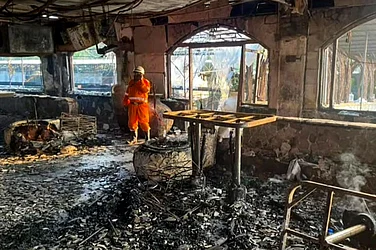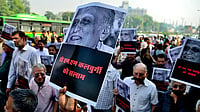In the Himalayas, glaciers are melting faster than ever before during the summers as global warming plays havoc with weather conditions across the globe. The melting glaciers often form lakes in the higher reaches, and soon turn into one of the biggest natural calamities in the hilly regions—flash floods due to glacial lake bursts. Several such glacial lake burst floods, often referred to as GLBF, have caused unprecedented devastation, including the 2013 Kedar valley flash floods in Uttarakhand. In Sikkim, a tiny northeastern state nestled in the Himalayas, the state government has been draining water from dangerously overflowing glacial lakes to turn the excess water into ‘ice towers’—which also become a repository of water for the hill state. In the cold desert of Ladakh, where water is a scarce and precious commodity, environmental engineer Sonam Wangchuk has ‘ice stupas’ as high as 65 feet; these become a source of water for the people in the driest months of the year.
ALSO READ: Poetry: Letter From A Former Cook
Across the world, communities are trying to adapt to a fast-changing world where extreme weather events—like frequent droughts, erratic rainfall and killer storms—are devastating lands and killing thousands of people every year. And India is sitting right in the middle of the powder keg of climate crisis. Consider this, temperatures in March were the hottest since the India Meteorological Department (IMD) began record-keeping about 122 years ago. While addressing all chief ministers through a video conference recently, PM Narendra Modi sounded the warning bell, “Temperatures are rising rapidly in the country, and rising much earlier than usual.” With the mercury hovering around 44° C in New Delhi, the country has plunged into a crisis spurred by frequent power outages and drinking water shortages. Whether homes, forests or farms, fire incidents have become more frequent; deaths due to heat stroke are also on the rise in the country.
While India has been witnessing the impact of changing weather patterns, the risks are already evident—from Kashmir to the coastal areas. Due to India’s underfunded and poorly-executed climate action plan, according to experts, the low-income and marginalised groups are at a greater risk of deadly heatwaves, disastrous floods and devastating cyclones. “India is already feeling the impacts of climate change,” a report by the Overseas Development Institute (ODI) revealed last year. Warning that extreme weather events are becoming more common and severe, the study compiled by the London-based global affairs think-tank further stated that “heavy rain events have increased threefold since 1950; and rising sea levels are posing new risks as a third of India’s population live along the coast”.
ALSO READ: Dante’s Peak: Heatwave Horror In Photos
Another report by the UN Intergovernmental Panel on Climate Change (IPCC) too predicted that India’s high vulnerability and exposure to climate change is going to threaten food security and slow the country’s economic growth, besides impacting health and overall development process, making poverty reduction even more difficult.
While several leading global climate economists think climate change will deepen income inequality between rich and poor countries, Bejoy K. Thomas, an associate professor at the Indian Institute of Science Education and Research, Pune, notes that the marginalised and vulnerable sections of society, especially in developing countries like India, will bear the burden of adverse effects of climate change. “The developing countries need to pursue development and improve living standards of their people, compared to wealthy countries. This presents a challenge, as development efforts will invariably have some level of environmental impact,” Thomas tells Outlook, endorsing India’s position at COP26 as “a pragmatic approach”.
On the scale of equity and fair-share principles, Sanjay Vashist, director, Climate Action Network South Asia, believes that India has committed more than its fair share, thus taking the burden of other countries as well. “The Nationally Determined Targets for 2030 are ambitious and the country is expected to achieve these before the deadline in 2030, but it’s the adaptation agenda where India has not been able to demonstrate adequate measures,” he says, elaborating that “the impacts from climate change are much faster than policy efforts. India faces a loss and damage situation, triggering migration from disaster-prone areas, but the policies/welfare schemes to provide relief are missing. India needs a national framework on loss and damage and climate finance from domestic sources.”
Thomas stresses on improved and timely information on weather and climate in rural, agrarian settings, and better management and development plans for cities taking a long-term perspective and climate risk into consideration. “There is only so much that countries like India can do to adapt given our constraints and priorities,” he says, asserting that “the mitigation measures have to be a global responsibility, especially of countries and sectors that can afford them”.
Earlier in February, while underlining dramatic growth in “loss and damage” associated with global warming, the flagship IPCC report, Climate Change 2022: Impacts, Adaptation and Vulnerability, had warned against unchecked emissions from fossil fuel use worldwide. India unveiled in its National Action Plan on Climate Change in 2007 and subsequently, different states prepared the respective state action plans on climate change. On the national efforts to adapt to accelerating climate change impacts, Harini Nagendra, noted author and director, Research Centre and Lead, Centre for Climate Change at Azim Premji University, tells Outlook, “Certainly, we have ambitious plans. But the scale of the crisis is massive and there are formidable challenges on the ground of various kinds—institutional, economic, ecological and societal—that have made it difficult for the plans to progress as envisaged.”
For instance, she adds, “the state action plans have not taken off the way they should have. We also need city and district action plans, devised keeping local climate projections in mind. While disaster planning for aspects like evacuation in times of flood and cyclones has forged ahead, how does one plan to evacuate half or more of India if there is a prolonged heatwave or drought? It is simply impossible.”
Chhering Tandup, an assistant professor at University of Jammu’s geography department, points at the correlation between climate change and the growing number of natural hazards in recent decades. “The Himalayan and coastal areas are more prone to climate induced hazards,” he stresses, adding that “the poor in these areas are at a greater risk of getting affected by extreme weather that can bolster the impact of natural disasters. Their prime source of livelihood is agriculture, which is bearing a negative impact of the changing climate. Consequently, the lesser privileged are migrating to other areas in search of alternative livelihood means”.
Referring to efforts by Ladakhi villagers to mitigate a water crisis triggered by climate change, Tandup says, “We need to involve local communities and local traditional knowledge in policy response to increasing climatic risks in the Indian Himalayas and coastal regions.” Underscoring India’s clean energy initiatives and the government’s decision to ratify the Kigali Agreement Amendment last year, Tandup stresses on better integration of several government agencies like the National Disaster Response Force, IMD and the Indian Space Research Organisation with the local administration for an effective implementation of the national climate action plan.
Due to restricted access to financial resources, infrastructure and the government’s welfare measures, Sanjay Vashist says that the poor and marginalised are the most vulnerable to extreme weather events. “If a farmer in a coastal area faces the impact of two cyclones within a season, for example, his yield is destroyed and the ongoing debt with high interest makes their coping capacity weaker. At the end, they are forced to migrate to make a living,” he tells Outlook. Nagendra also stresses on localised planning and action. Suggesting mitigation and adaptation measures, she stresses that besides efforts at the national scale, there is a need for a polycentric or multi-level governance approach, so that actions at village, city and district scales are nested within taluk, state and national action plans. To cut India’s vulnerability and exposure to extreme weather events, she says, “We need to really look at ecosystem protection and restoration as a way to provide both mitigation and adaptation.”
Citing forest restoration with local communities as an example, she goes on to add, “It will strengthen social capital, provide livelihoods, sequester carbon, protect biodiversity and mitigate local and regional climate shifts. Similarly, planting the right kinds of trees in the right places in cities, and restoring urban water bodies, will help protect against floods, increase groundwater recharge, and ameliorate the effects of heatwaves and air pollution. This also means, of course, that we need to protect functioning ecosystems where they are present first—and then only restore—so wetlands, forests, grasslands, mangroves, etc must be protected from further loss because of infrastructure expansion.”
(This appeared in the print edition as "Doom and Gloom")
ALSO READ


























